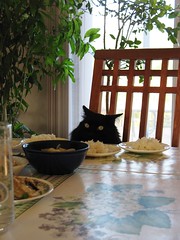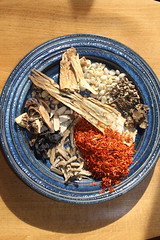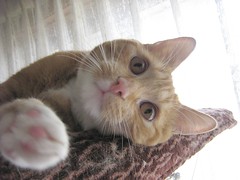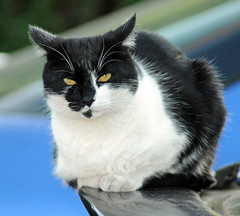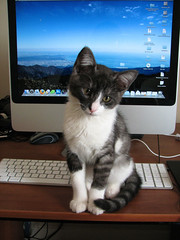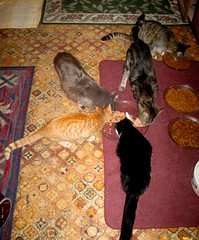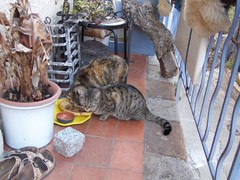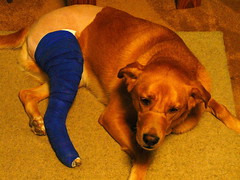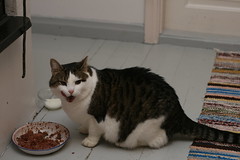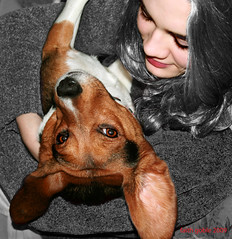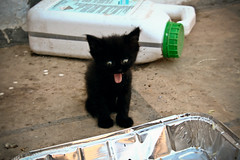Diets for cancer in cats and dogs – you are what you eat, a fighting cancer machine
Sunday, May 1st, 2011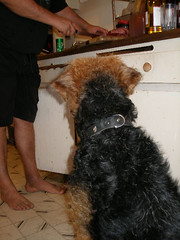 Good nutrition is very important in any animal fighting cancer. You are what you eat and with cancer we need a diet that feeds and supports the body but starves the cancer. In fighting cancer with herbs and holistic medicine, we are relying on the body to do the fighting. This takes a strong immune system and a lot of energy. You need good food for this.
Good nutrition is very important in any animal fighting cancer. You are what you eat and with cancer we need a diet that feeds and supports the body but starves the cancer. In fighting cancer with herbs and holistic medicine, we are relying on the body to do the fighting. This takes a strong immune system and a lot of energy. You need good food for this.
Cancer cannot utilize fats but loves to use carbohydrates, especially processed ones. Protein is somewhere in between.
A diet high in protein, moderate in fat and with no grain or very low grain is ideal. Home-made cooked, or raw diets are best. If that is not possible then a good quality high protein, canned commercial diet or a hydrated freeze dried raw diet can be substituted.
If your animal is undergoing chemotherapy or radiation you should not use a raw diet (freeze dried is fine). However for these animals a great option is a cooked diet. After they are done with these treatments the food can slowly be transitioned to raw if desired.
If your dog or cat is very debilitated from cancer and has not been on a raw diet before stick with a cooked or freeze dried food.
Commercial raw diets can be cooked as a more simple way to make home cooked food for your animal.
Below are a couple diets I have been using for years for my clients who have time to home cook. It is not an exact science so feel free to play around with them. Scroll down to see some of the commercial diets I recommend (canned, freeze dried and raw).
Dog (approximately for a 40 lb dog per day)
- 1 1/2 cups cooked or raw meat including liver and organ meat (if you use fish or pork make sure it is cooked)
- 1 cup cooked vegetables
- 1/4 cup yam, sweet potato or pumpkin, cooked or canned
- 1/8 cup nuts such as almonds, walnuts, or cashews
- 2 T yogurt with live cultures
- 1 egg
- 1 teaspoon Nordic Naturals Pet Cod Liver Oil
- a calcium supplement (see below)
Cat Cancer Diet See Making Crazy Awesome Homemade Cat Food
- 6 pounds of meat or fish ground or chopped(about 1-1/2 cup)
- 1/4-1/2 cup liver and organ meat
- 8 eggs
- one 15 ounce can of pumpkin, sweet potato, or yam
- six teaspoons Nordic Naturals Pet Cod Liver Oil
- 6 teaspoons almond butter
- 3 grams Taurine Powder
(if the meat is cooked or if using fish) - Animal Essentials Natural Seaweed Calcium
or see below
An alternative cat food recipe is Making Crazy Awesome Cat Food Part Two.
For homemade dog food (cats are hard to add extras to their food)
- If possible I also recommend adding reishi, shitake, and/or maitake mushrooms to the diet. Mushrooms are strong immune stimulates and have anti-cancer properties. Add them in as some of the veggies. Mushrooms should always be cooked as the cooking releases their helpful properties and when they are not cooked they are mildly toxic. Alternatively Fungi Perfecti, in my opinion the best mushroom company around, offers a great powdered supplement called MUSH.
- When picking vegetables, broccoli and other leafy dark green vegetables should be considered. Many studies have been done on broccoli’s effects against cancer. See the article Broccoli Fights Cancer.
- I am not a large user of supplements, but I love Healthforce’s Vitamineral Powder
and feel like it adds in both micronutrients and some added digestive support.
- The pumpkin, sweet potato, yam, and cod liver oil are high in Vitamin A. Vitamin A promotes mechanisms in the body that kill cancer cells and cause cell differentiation. Consider adding other sources of vitamin A such as liver and carrots.
- A calcium supplement needs to be added to any diet made for cats and dogs. There are many ways to do this.
- There are many commercial products such as Animal Essentials Natural Seaweed Calcium
.
- Bone Meal Powder
can also be used. Use one teaspoon for an average sized dog.
- Many people prefer to add a Centrum Silver
a day for average to large sized dogs.
- If you are feeding a raw diet you can feed raw chicken necks for calcium.
- If you are using eggs in your diet consider smashing up the egg shell and adding it to the diet. One egg shell provides enough calcium for an average sized dog. 1/8-1/4 of an eggshell provides enough for a cat.
- There are many commercial products such as Animal Essentials Natural Seaweed Calcium
- If you are making raw food make sure the meat is frozen for at least 48 hours to kill off any dangerous parasites.
- Nuts such as walnuts, almonds and cashews are high in trace nutrients, minerals, vitamins and good fats. If possible include these in your diet. Cats sometimes do better with a little almond butter. Avoid macadamia nuts which are toxic to dogs.
If you are using a commercial canned food I recommend the following
- Weruva
is a great food that seems home made. They have many varieties so make sure you find a grain free one. I have found this food much cheaper on Amazon.com
- Instinct
is completely grain free and very high in protein.
- Taste of the Wild
is another quality food I use in a lot of the dogs I work with.
- There are other good ones out there but make sure they mostly contain meat and are grain free.
If you are using a commercial raw diet ideally pick one local to your area. I really like Darwin’s for raw dog and cat food and Rad Cat for cats.
For commercial home cooked food and raw food for cats and dogs in the Seattle area, Natural Pet Pantry is a good option. Fresh and local food and run by knowledgable and kind folks.
If you are looked for a good freeze dried raw Stella & Chewy’s is my favorite and even picky animals including cats seem to like it. With any of the freeze dried foods I recommend hydrating them.
I hate to see dogs and cats with cancer on dry food but if that is the only option then a no grain high quality diet such as Orijen can be used.
Remember that any food in the belly is more important then the best food sitting uneaten. Sometimes animals with cancer are so sick that they have very little appetite. In that case give them anything they will eat. When they are feeling better, focus on trying to get them to eat what is best for them.
Return to Integrative and Holistic Methods for Treating Cancer in Cats and Dogs.


